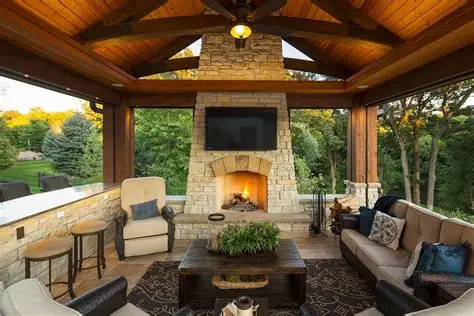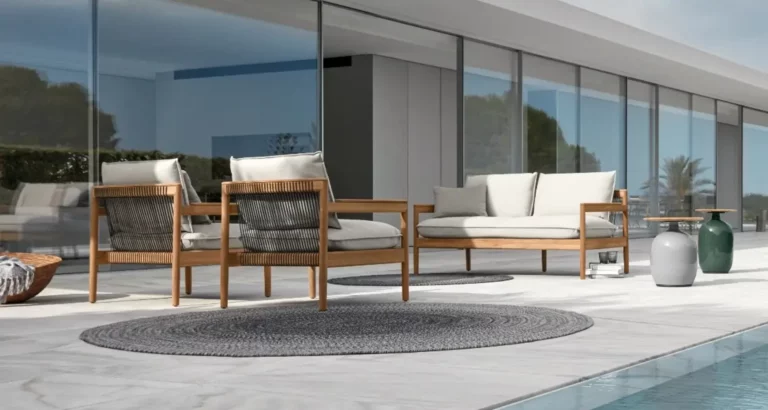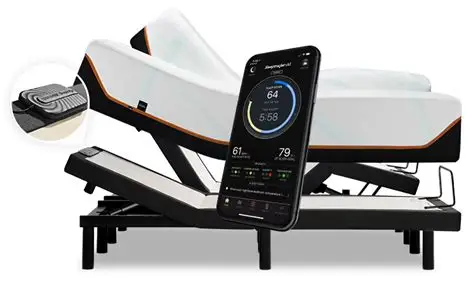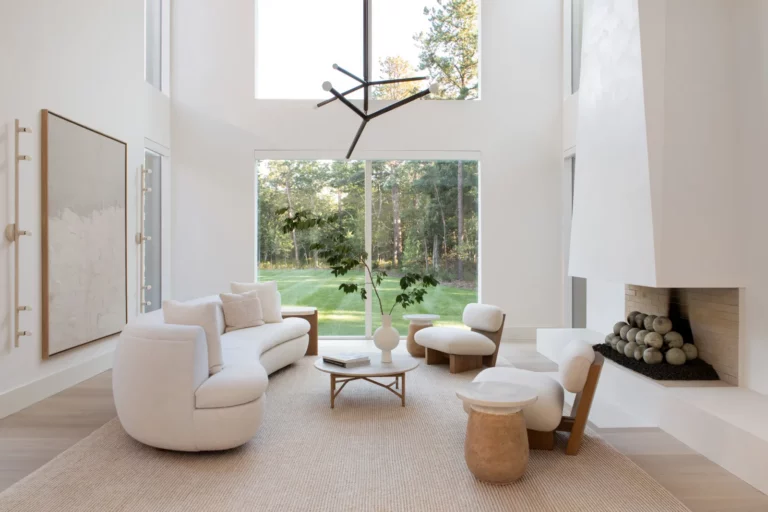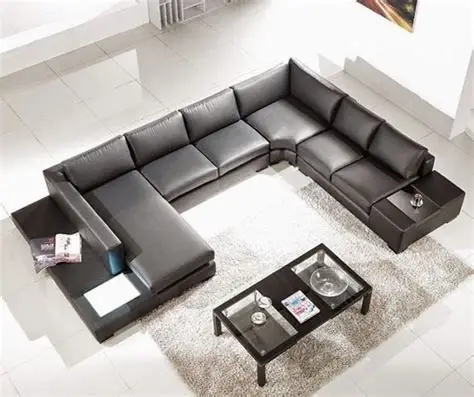Designing the Perfect Outdoor Living Room
Creating an outdoor living room is one of the most satisfying upgrades you can make to your home. Instead of simply a patio or a deck, an outdoor living room becomes a comfortable extension of your indoor space a place where you relax, host guests, and connect with nature. In this article, you’ll learn what elements matter, why they matter, and how to choose real-world products. We’ll also explore five high-quality furniture sets you can buy today.
Why an Outdoor Living Room Matters
When you design an outdoor living room, you’re investing in more than furniture; you’re investing in lifestyle. A well-designed space supports relaxed conversations, impromptu evenings outdoors, fresh-air breakfasts, and more. It encourages you to spend time outside rather than always indoors. Moreover, with the right layout and materials, you get a durable space that holds up through changing seasons and weather.
Comfort and durability come together when you choose smart materials. According to expert reviews, elements like performance fabrics, weather-resistant frames, and all-weather furniture make a big difference in how a space feels and how long it lasts.
Also, the design inspiration sources list key features: layered seating, defined zones (e.g., lounge zone, dining zone), outdoor rugs, lighting, and alternative shade or shelter.
Key Benefits
Functional extension of indoors. With the right furniture and layout, your outdoor area becomes comfortable enough to be used as a living room complete with sofas, side tables, lounge chairs, maybe a fire pit or coffee table.
Enhanced well-being. Being outdoors has benefits: fresh air, natural light, relaxing ambiance. A cozy outdoor living room invites more of that.
Entertaining value. A purpose built space makes hosting easier and more enjoyable whether it’s a family dinner, a drink with friends, or quiet reading time.
Long-term investment. Quality outdoor furniture and materials can last many seasons, reducing upkeep and replacement cycles.
Planning Your Layout and Zones
To design the perfect outdoor living room, you need clear zones and a good flow. Treat it like an indoor living space but adapt for outdoor conditions.
Defining Seating Zones
First, decide how you will use the space. Will you lounge, dine, entertain, or a mix of all? Once you have clarity, you can define zones accordingly.
-
Lounge zone: This is where you have sofas or lounge chairs. Think comfort and relaxation.
-
Dining or bar zone: If you entertain, you may want a table, or a counter-height bar area.
-
View or garden-facing zone: Orient seating so people face attractive landscaping, a pool, or open space.
-
Transition zone: Make sure people can move easily from indoors to outdoors and between zones without obstacles.
Traffic Flow and Space Efficiency
An outdoor living room must consider circulation walkways, access to doors, shade areas. Avoid placing oversized pieces that block movement. For smaller patios or balconies, prefer modular furniture or compact designs so the area doesn’t feel cramped. The source from IKEA Indonesia recommends multifunctional furniture and vertical elements for smaller spaces.
Choosing Materials That Last
Because outdoor furniture faces sun, rain, wind, and varying temperatures, material choice is critical.
What to Look For
-
Weather-resistant frames and fabrics: Materials like aluminum with powder-coating, synthetic resin wicker, HDPE, or teak are among the best.
-
All-weather fabrics: Fabrics treated for UV resistance, quick-drying, mold/mildew resistant. These features extend the life of cushions.
-
Low maintenance: The less you need to do upkeep (e.g., sealing wood, covering metals, storing cushions) the more you’ll use and enjoy the space.
-
Aesthetics and durability combined: Materials should look good and perform. For instance, teak is prized because its natural oils resist decay and insects, and it develops a pleasing patina over time.
Why These Matter
When furniture fails (rusts, warps, fades, cushions become water-logged), the space loses its appeal and you stop using it. By choosing durable materials, you ensure the outdoor living room remains welcoming for years. The investment pays off in both comfort and longevity.
Lighting, Accessories & Comfort
Your outdoor living room needs more than just furniture it needs ambiance, comfort, and adaptability.
Lighting for Ambience and Function
Outdoor lighting should be layered:
-
Ambient: Overhead string lights, lanterns, or consistent light sources across the space.
-
Task: Reading lights near lounge chairs or lighting near the dining zone for meals.
-
Accent: Spotlights on plants, fire-pit glow, or uplights to architectural features.
Good lighting extends usability into the evening and sets mood. Inspiration sites highlight pergolas with string lights and cozy outdoor rugs to create defined, comfortable zones.
Comfort Through Accessories
To make the space feel truly inviting:
-
Add throw cushions and blankets to soften seating and make it cozy (especially useful for cooler evenings).
-
Use an outdoor-rated rug to define the lounge zone and add warmth underfoot.
-
Incorporate shade or shelter (e.g., pergola, umbrella, canopy) so the area is usable during day and evening.
-
Add plants and nature-inspired elements they make the space feel connected to its outdoor environment.
Real-World Product Examples
Here are five excellent furniture sets to consider, each with specific strengths. For every product, we’ll cover what it offers, why it works, and what problems it solves.
1. Nämmarö Outdoor Furniture Set
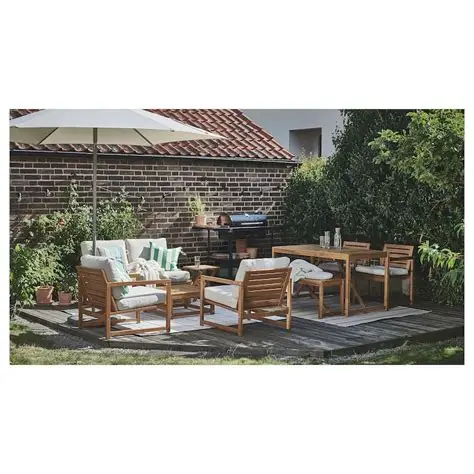
Sofa set for living room in philippines
The Nämmarö set from IKEA is a modular wood lounge set that typically includes pieces for several seats and a coffee table. It uses solid wood, with clean lines and a natural wood finish.
Why it works:
-
Modular design lets you configure it to your space good for smaller patios or larger setups.
-
The open wood slat design gives visual lightness, preventing a dense “block” of furniture that might overwhelm an outdoor space.
-
Natural material connects to the outdoor environment.
Problems it solves:
-
For many outdoor spaces, finding furniture that feels like “real living room seating” can be hard because many outdoor pieces feel like lawn chairs. This set bridges that gap.
-
If you have a mid-budget and want wood furniture but worry about durability the modular nature lets you start small and add over time.
2. Midland Modern Solid Wood 3‑Piece Outdoor Sectional Set

This is a solid-wood (often teak or similarly durable hardwood) three-piece sectional set: typically a sofa and chaise or two chairs and a coffee table, with plush outdoor cushions.
Why it works:
-
Sectional layout creates a true lounge zone outdoors the kind you might find inside a living room.
-
High-quality wood means durability plus style.
-
The cushions raise comfort to “indoor-style” levels so your outdoor space is genuinely usable for relaxing.
Problems it solves:
-
If you’ve avoided outdoor seating because typical patio chairs are uncomfortable, this set addresses comfort directly.
-
If your outdoor area lacks identity (just random chairs), this gives it a defined “living room” feel.
3. Vicllax Versatile Wicker Patio Set: 5 Pieces with Fire Table

This is a five-piece patio set featuring synthetic wicker (all-weather rattan) with cushions and a fire table at the center.
Why it works:
-
Synthetic rattan is known for weather performance resistant to sun, rain, fading. Rattan’s durability outdoors is documented.
-
The fire table adds an element of warmth and atmosphere great for evenings and creating a gathering point.
-
Conversation set layout (sofas chairs fire table) gives a social layout perfect for entertaining.
Problems it solves:
-
If you struggle with “empty feeling” outdoor spaces, the fire table anchors the zone and offers function (lighting heat).
-
If your climate has both sun and cooler evenings, the fire table extends usability.
-
If you are worried about material durability (e.g., natural wicker or untreated wood), synthetic rattan gives low-maintenance performance.
4. Outsunny 7‑Piece Patio Furniture Set
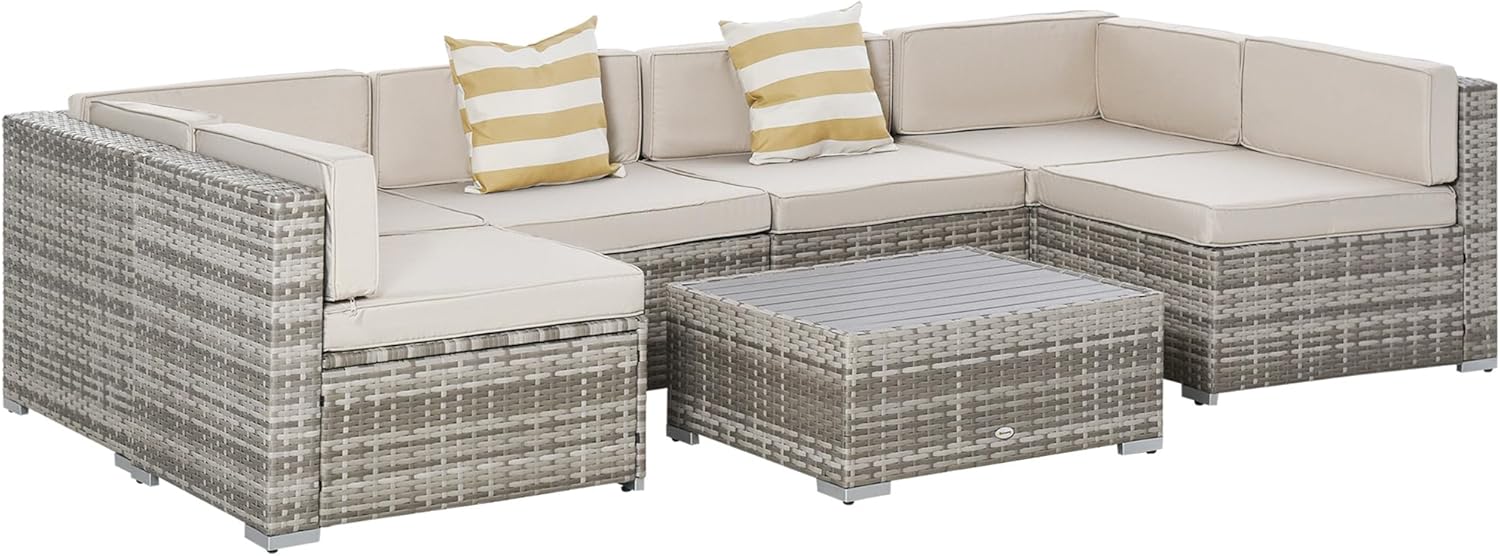
This is a seven-piece set sized for larger outdoor spaces. It uses weather resistant materials (wicker or metal cushions) and includes multiple seating components plus a table.
Why it works:
-
Great for families or social outdoor spaces enough seats for several people.
-
Modular seating allows flexibility rearrange for different gatherings or relaxing.
-
The larger set size fosters the outdoor living room feel, rather than “a couple of chairs”.
Problems it solves:
-
For homes with multiple people or frequent guests, a small bistro set won’t suffice this gives the capacity.
-
If your outdoor area feels under-furnished and you want to define a lounge zone, this solves that.
-
If you prefer to choose one set rather than accumulating pieces over time, this gives a full setup.
5. SAFAVIEH Outdoor Living Collection Bradbury 4‑Piece Set
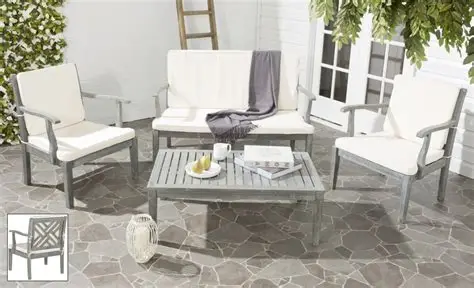
Safavieh Bradbury 4pc Outdoor Living Set Ash Grey
This is a more compact four-piece set from a recognized brand, good for mid-sized patios or corners of a garden. It uses durable materials and cushions.
Why it works:
-
Recognized brand gives some assurance of quality.
-
Four-piece layout offers balance enough seating for a family lounge zone without taking over the entire yard.
-
Design is versatile and can suit many outdoor styles (modern, transitional, etc).
Problems it solves:
-
If your budget or space does not allow a large sectional, this gives a “living room experience” in a smaller footprint.
-
If you want brand reliability but still value design and comfort, this set fits.
-
If you wish to start with a smaller setup and expand later, this is a realistic entry.
How to Buy: What to Check & Where
When purchasing outdoor living room furniture, follow these steps for a smart decision:
-
Measure your space width, depth, any fixed features (walls, posts, plants). Ensure the furniture fits with walkways and zones.
-
Pick materials appropriate for your climate are you in a rainy/heavy humidity zone, or sunny/UV intensive region? Choose accordingly. For example, aluminum and synthetic wicker are excellent in wet or humid zones.
-
Check fabric specifications outdoor cushions should be fade-resistant, quick-drying, mildew resistant. All-weather fabrics list these benefits.
-
Select a layout that suits your use lounge zone? dining zone? combination? Then match product layout accordingly (chair count, sofa size, table type).
-
Buy from trusted retailers ensure clear information about shipping, assembly, returns, and material warranties. Online and local stores both work; compare.
-
Look for deals and timing off-season or clearance times often mean better pricing. Some buyers note end of summer as major discounts.
-
Plan for maintenance and covers even the best materials need occasional care. Using covers, storing cushions, cleaning frames will extend life.
Use Cases & Problem Solving
Understanding how a good outdoor living room solves problems will help you choose wisely and justify the investment.
Use Case: Entertaining Guests
Problem: You only have folding chairs and a small patio guests feel cramped and you scramble for seating.
Solution: With a five- or seven-piece set (e.g., Vicllax or Outsunny above), you have ample seating arranged in conversation style around a fire table or coffee table. Guests feel comfortable, the layout supports chatting, and the materials hold up outdoors through the evening.
Use Case: Daily Relaxation after Work
Problem: After a long day, you don’t want to retreat indoors only to sit on a stiff patio bench.
Solution: A sectional set (e.g., Midland Modern) offers sofa style comfort under open sky. Cushions provide comfort, the layout invites lounging, and you spend more time outside enjoying air and relaxation rather than just cooking and eating indoors.
Use Case: Maximizing Small Outdoor Space
Problem: You have a small balcony or narrow patio and traditional bulky furniture overwhelms the space.
Solution: A compact four-piece set (e.g., SAFAVIEH) or modular wood set (Nämmarö) gives seating without dominating the area. You maintain clear walkways, the area feels open, and the furniture scales to your space.
Use Case: Low Maintenance Lifestyle
Problem: You want an outdoor lounge but dread the upkeep of outdoor furniture (rust, cushions wet, re-sealing wood).
Solution: Choose all-weather materials: synthetic wicker or powder coated aluminum frames, quick-dry cushions, and high-quality fabrics. As sources emphasize, investing in weather-resistant furniture reduces replacements and maintenance.
Use Case: Year-Round Outdoor Use
Problem: The patio is only usable in summer; beyond that it’s either too cold, too dark, or too exposed.
Solution: Include features like a fire table or outdoor heater (Vicllax example), layered lighting for evenings, and maybe a pergola or canopy for shade/shelter. The materials you choose must hold up through seasons. Design guides suggest planning for all seasons is essential.
Final Thoughts
Designing the perfect outdoor living room means more than picking a few chairs and a table. It means creating a zone that feels purposeful, comfortable, and well built one that you want to use. With the right planning, materials, accessories, and layout, your outdoor area can become a true extension of your home.
Start by visualizing how you’ll use the space. Then choose a furniture set that aligns with that vision and your environment. Use the real-world product examples above as benchmarks or starting points. Measure your area, consider your climate, and buy with durability and comfort in mind. Once set up, layer lighting, rugs, cushions, and plants to bring the space to life.
This investment pays off in relaxation, social time, fresh air, and a well-used outdoor living space you’re proud of. Choose wisely, maintain thoughtfully, and enjoy the outdoors more than ever.
Frequently Asked Questions
Q 1: How much space do I need for an outdoor living room?
A: There’s no strict minimum, but you want enough at least for one sofa or sectional and access space (walkways). For a comfortable lounge zone, aim for at least 10′ × 12′ (≈3 m × 3.6 m) if possible. If your space is smaller, choose compact or modular furniture suited for smaller footprints.
Q 2: What materials should I avoid for outdoor furniture?
A: Avoid untreated iron or steel (which can rust easily), soft woods that aren’t weather-treated, cushions made of indoor fabrics, and plastics that are not UV-stable or designed for outdoor use. These items will age poorly and incur high maintenance.
Q 3: How do I maintain outdoor furniture to make it last?
A: Regular cleaning (mild soap + water), covering or storing cushions when not in use or in off-season, checking for damaged finish or rust spots, resealing wood if needed, and placing furniture under some cover or shade when possible. Even for “weather-resistant” materials, periodic care extends lifespan significantly.

